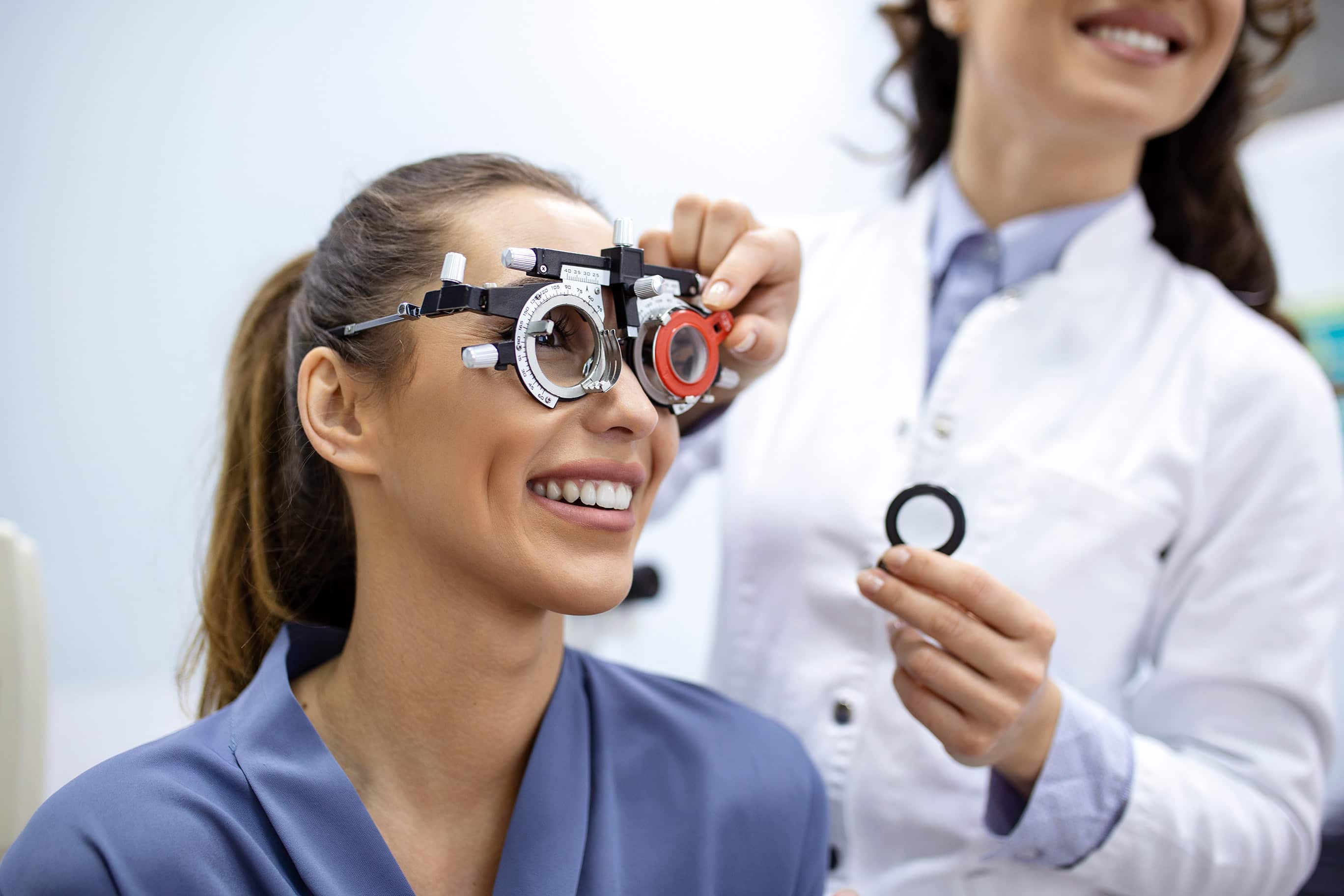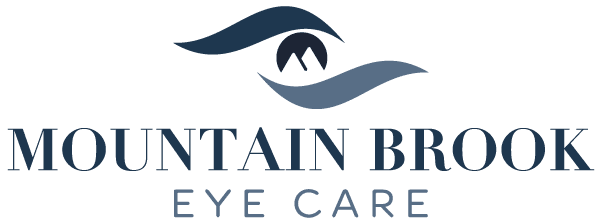What is Astigmatism, And Can It Be Fixed?

If you’ve ever noticed that your vision seems slightly blurry or distorted, even when objects are close or far away, astigmatism could be the cause. At Mountain Brook Eye Care, we see this condition every day and help patients regain sharp, comfortable vision with individualized treatment options.
Astigmatism is a common refractive error caused by an irregular curvature of the cornea or lens. This uneven shape bends light unevenly as it enters the eye, leading to blurred or distorted vision at all distances. The good news is that astigmatism is highly treatable. With today’s technology and treatment options, nearly everyone can achieve clear, focused vision again.
At Mountain Brook Eye Care in Mountain Brook, AL, we combine advanced diagnostic tools, professional expertise, and personalized eye care to restore visual clarity for every patient.
This Article Will Address:
- What causes astigmatism
- The different types of astigmatism
- How astigmatism is diagnosed
- Treatment and management options
- Whether laser surgery can correct astigmatism
What Causes Astigmatism?
Astigmatism occurs when the cornea or the internal lens of the eye has an irregular curve. Instead of being round like a basketball, the surface is shaped more like a football, which causes light to focus on multiple points in the eye rather than one sharp point on the retina.
This condition can be hereditary, meaning it often runs in families. It can also develop after an eye injury, eye surgery, or as a result of natural changes with age. Other subtle factors, such as constant eye rubbing or the way the eyelids press against the cornea, may also influence its development.
A common myth is that reading in dim light or sitting too close to a screen causes astigmatism. These activities can contribute to eye strain but do not change the eye’s physical shape.
What Are the Different Types of Astigmatism?
Astigmatism can vary in its cause and severity. Understanding the type helps determine the best method of correction.
Corneal vs. Lenticular Astigmatism
- Corneal astigmatism: Occurs when the cornea, the clear front surface of the eye, has an uneven curvature.
- Lenticular astigmatism: Happens when the internal lens behind the cornea is irregularly shaped.
Regular vs. Irregular Astigmatism
- Regular astigmatism: The most common form. The cornea’s curve is consistent but slightly off, making it easily corrected with glasses or contact lenses.
- Irregular astigmatism: Less common and often caused by trauma, surgery, or certain eye diseases. It usually requires specialized lenses or surgical options.
Approximately one in three people have some degree of astigmatism, which makes early diagnosis an important part of maintaining healthy vision.
How Is Astigmatism Diagnosed?
At Mountain Brook Eye Care, astigmatism is diagnosed during a comprehensive eye exam that evaluates both vision quality and eye health. Dr. Jeremy Edgerly uses advanced diagnostic tools, including the Optos Monaco for wide-field retinal imaging and Neurolens technology to measure visual alignment and comfort.
During your exam, several tests are used to assess astigmatism:
- Visual acuity test: Reading letters on an eye chart to measure clarity.
- Keratometry or corneal topography: Measuring the curvature and shape of the cornea.
- Refraction test: Determining the correct prescription for clear vision.
What to Expect During Your Eye Exam
From start to finish, your visit is designed for comfort and education. Dr. Edgerly takes the time to explain each step of the process, review your results, and discuss how astigmatism may be affecting your daily vision. Our goal is to ensure you leave with both answers and solutions.
What Are the Treatment Options for Astigmatism?
Astigmatism is easily managed with modern vision correction solutions tailored to each patient’s needs.
Eyeglasses
Custom eyeglass lenses correct the uneven light refraction caused by astigmatism, resulting in sharp, balanced vision. Patients at Mountain Brook Eye Care can choose from a curated selection of luxury frames, including Ic! Berlin, Sospiri, Tom Davies, Götti, and Ørgreen. Every pair is chosen for comfort, craftsmanship, and style.
Contact Lenses
Several contact lens designs effectively correct astigmatism:
- Soft toric lenses for everyday comfort.
- Rigid gas-permeable lenses for sharper clarity.
- Hybrid and scleral lenses for irregular corneas or higher prescriptions.
- Orthokeratology (Ortho-K) lenses gently reshape the cornea overnight, allowing clear daytime vision without lenses or surgery.
Refractive Surgery Options
Patients seeking a long-term solution may consider LASIK, PRK, or LASEK. These laser procedures reshape the cornea to correct the irregular curvature and improve how light focuses on the retina. Each option is evaluated carefully to match patient safety, corneal health, and visual goals.
Is Laser Surgery (LASIK/PRK) an Option for Astigmatism?
Many patients with mild to moderate astigmatism are excellent candidates for laser vision correction. Procedures like LASIK or PRK reshape the cornea to correct the irregular curvature, resulting in lasting visual improvement.
Factors such as age, corneal thickness, and prescription stability determine candidacy. At Mountain Brook Eye Care, Dr. Edgerly collaborates closely with local refractive surgeons to ensure a seamless, safe co-management process from evaluation to follow-up care.
New advancements, such as SMILE surgery, continue to expand treatment possibilities, offering even more precise results for certain prescriptions.
Can Astigmatism Be Prevented or Worsening Avoided?
While astigmatism itself cannot be prevented, its effects can be managed through consistent, professional eye care. Routine eye exams every one to two years allow early detection and help track changes in prescription or eye health.
Children, adults with eye strain, and anyone experiencing fluctuating vision should prioritize regular visits to maintain clarity and comfort.
Living with Astigmatism in Mountain Brook, AL
With the right correction, astigmatism does not have to limit your lifestyle. Patients often find that once corrected, their headaches, eye strain, and blurry vision disappear.
For daily comfort:
- Use proper lighting while reading or using screens.
- Consider blue-light lens coatings to reduce fatigue.
- Support long-term eye health with MacuHealth supplements, available at our office.
At Mountain Brook Eye Care, we emphasize proactive care and education so you can enjoy lasting visual wellness.
Why Choose Mountain Brook Eye Care for Astigmatism Treatment?
Led by Dr. Jeremy Edgerly, our practice combines medical expertise with personal attention. We specialize in ocular disease management, contact lens fittings, and refractive surgery co-management, ensuring patients receive complete care under one roof.
Our modern facility features state-of-the-art diagnostic technology, a comfortable environment, and an extensive selection of designer eyewear. Every detail of your visit is designed to make vision care both effective and enjoyable.
At Mountain Brook Eye Care, we believe in comfort, clarity, and personalized vision care for every patient in Mountain Brook, AL.
Ready to See the World Clearly?
At Mountain Brook Eye Care, we help patients overcome blurry or distorted vision through advanced diagnostics, personalized treatments, and ongoing education. Whether you need glasses, contact lenses, or surgical guidance, Dr. Edgerly and our experienced team are ready to help you achieve clearer sight and renewed confidence.
Schedule your comprehensive eye exam today at Mountain Brook Eye Care in Mountain Brook, AL, and discover the difference personalized eye care can make.
Sources:
Dr. Jeremy Edgerly
Dr. Edgerly has been actively practicing optometry since 2012 in a family practice setting. He is confident in his ability to accurately diagnose, treat and manage conditions of the eye and local structures. He attended the University of Alabama at Birmingham and earned a Bachelor of Science. Upon completing his undergraduate studies, he enrolled in the UAB School of Optometry, where he earned a Doctorate in Optometry. There, he received specialized training in ocular diseases, contact lenses, pediatrics, and refractive and cataract surgery co-management.

